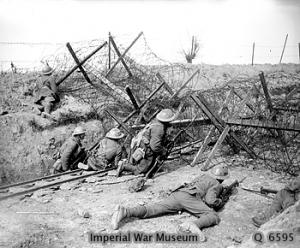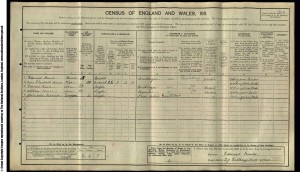
William’s 10th Battalion, Queen’s (Royal West Surrey Regiment) lie behind a wire ‘block’ on a road at St Jean during the Battle of the Lys, 29 April 1918.
William Thomas Rance Died 20th May 1918
William was born in 1891 in Wokingham, to father, Edward and mother Ann . He was the second born and had two siblings, a brother Edward and a sister, Gertrude. By Victorian standards, this was not a big family, probably because Ann was in her early thirties when she married Edward, who was ten years her junior. However, all three children survived into adulthood and by 1911, the family takes on a comfortable look with Edward as a bricklayer, as is son Edward and William is a carpenter. Gertrude, herself 18 years old at this time is working on a farm as a ‘harvest maid’. In 1911, he and his parents lived on the Easthampstead Road, Wokingham. By 1914, William had married Lucy Ellen Long and they moved just around the corner to 7 Wescott Road. This road was particularly badly affected by the war as we have already found seven losses along here. Wescott Road is quite small, not much more than 400 yards long.
William joined the Royal Fusiliers, 26th Battalion. This battalion was described as ‘The 26th (Service) Battalion the Royal Fusiliers(Bankers) was raised early in 1915 from bank clerks and accountants by Major William Pitt, an old Volunteer officer. The 26th was one of the two Fusilier battalions to see service in Italy; but they were brought back to France early in 1918 in time for the German March offensive. It was during this time and possibly just after fighting in the Battle of Lys, that William lost his life. Following the movement of German troops from East to West (a result of the Russian Revolution) the Germans threw its excess armies into battle, now known as ‘The Spring Offensive’ of 1918. Both sides suffered heavy losses during this period, some 250,00 men. We know Lys to be near William’s final resting place, although the major part of this battle had finished some weeks prior to his death.
A small article in the Reading Chronicle on 1st June 1918 tells of his death;
“Member of town band killed. News of the death of Private W Rance of 27 Easthampstead road has been received. He was well known in Wokingham and a member of the town band. He was the 2nd son of Mr and Mrs Rance, an elder brother Private T Rance being now at the front. Deceased leaves a widow and child. Mr and mrs Rance have now lost 3 newphews a brother-in-law and a son in the war. “
Name: RANCE, WILLIAM TOM
Rank: Private
Regiment/Service: Royal Fusiliers Unit Text: 26th Battalion. Secondary Regiment: The Queen’s (Royal West Surrey Regiment) Secondary Unit Text: attd. 10th Battalion.
Age: 27
Date of Death: 20/05/1918
Service No: 22689
Additional information: Son of Edward and Annie Rance, of 27, Easthampstead Rd., Wokingham; husband of Lucy Ellen Rance, of 7, Wescott Rd., Wokingham.
Grave/Memorial Reference: IX. E. 12. Cemetery: YPRES RESERVOIR CEMETERY
From October 1914 to the autumn of 1918, Ypres (now Ieper) was at the centre of a salient held by Commonwealth (and for some months by French) forces. From April 1915, it was bombarded and destroyed more completely than any other town of its size on the Western Front, but even so certain buildings remained distinguishable. The ruins of the cathedral and the cloth hall stood together in the middle of the city, part of the infantry barracks stood in an angle of the south walls and the prison, reservoir and water tower were together at the western gate. Three cemeteries were made near the western gate: two between the prison and the reservoir, both now removed into the third, and the third on the north side of the prison. The third was called at first the “Cemetery North of the Prison,” later “Ypres Reservoir North Cemetery, and now Ypres Reservoir Cemetery. This cemetery was begun in October 1915 and used by fighting units and field ambulances until after the Armistice, when it contained 1,099 graves. The cemetery was later enlarged when graves were brought in from the battlefields of the salient and the following smaller burial grounds:- YPRES RESERVOIR SOUTH CEMETERY, between the prison and the reservoir (also called “Broadley’s Cemetery” and “Prison Cemetery No.1”). It was used from October 1914 to October 1915, and contained the graves of 18 soldiers from the United Kingdom. YPRES RESERVOIR MIDDLE CEMETERY, immediately North of the last named (also called “Prison Cemetery No.2” and “Middle Prison Cemetery”). It was used in August and September 1915, and rarely afterwards. It contained the graves of 107 soldiers from the United Kingdom (41 of whom belonged to the 6th King’s Own Yorkshire Light Infantry) and one Belgian soldier.
7 Wescott Rd, Wokingham (wife)
27 Easthampstead Road, Wokingham (1911)

